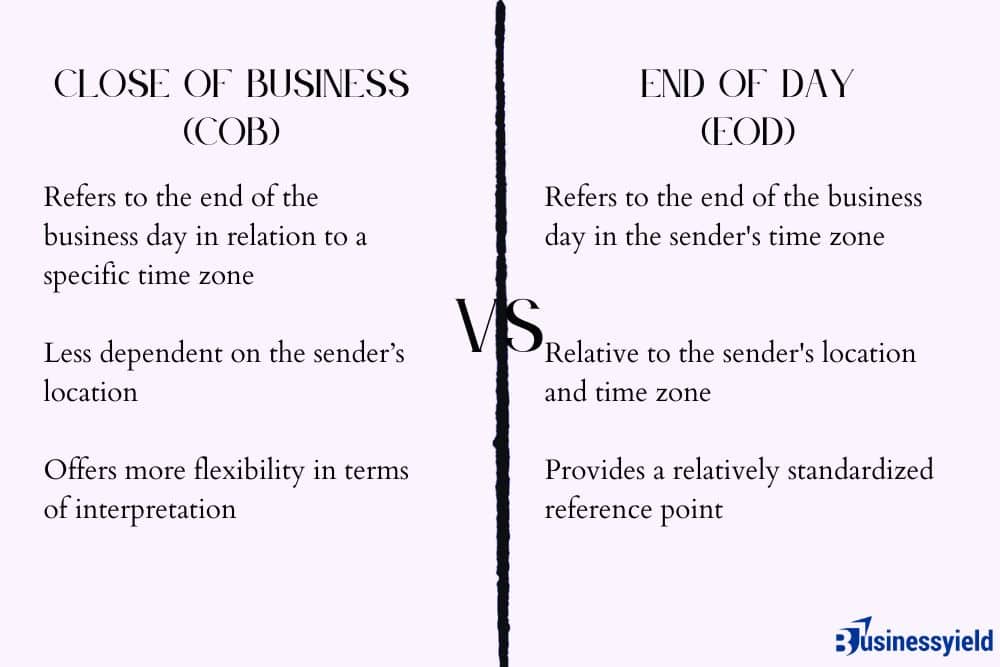EOD, COB, COP, TBD—these are just a few of the acronyms that you will need to be familiar with as you venture into the world of business. And if you happen to be a little confused at first or mix them up, don’t panic. It happens to all of us at some point.
In fact, I remember the first time I received an email with the closing remark, “Report to be submitted by EOD Tuesday…”, and I wondered what my supervisor needed an explosive for (EOD is also a military term for Explosive Ordinance Disposal). Thank goodness I looked the meaning up before ordering some C4 on Amazon.
Acronyms are an efficient way for business professionals to communicate with one another. When a supervisor assigns a task, they may detail whether it’s due at the end of the day (EOD) or close of business (COB). It’s important to know the meanings of these acronyms to avoid missing any important deadlines.
So, for the safety of your supervisor, team and organization as a whole, I will show you what EOD means in business. I will also show you how to use it to communicate effectively.
Key takeaways
- “EOD” stands for “end of day.”
- Often used in business settings, the term notifies the recipient that something will be happening by the end of the workday.
- Whether you need to quickly file a report or a new meeting has been added to your schedule, the term denotes a deadline.
- You can also put a day of the week (i.e. Monday or Thursday) after “EOD” to specify further.
What is EOD?
EOD stands for “end of the day,” which refers to the end of the business day. Some employers may use EOD and COB interchangeably, but they have a few key differences. When supervisors assign tasks to be completed by EOD, they expect employees to complete them by the end of the business day in their own time zone.
If someone assigns a task to someone in a different time zone, then it’s usually due by the end of the business day in the sender’s time zone.
What are business days?
Business days, also known as working days, are the weekdays when most businesses and organizations operate and conduct their regular activities. These days typically exclude weekends (Saturday and Sunday) and official holidays. Business days are essential for conducting various business-related operations, such as transactions, meetings, customer service, and administrative tasks.
Many businesses operate between 9 a.m. and 5 p.m. on these days. The exceptions to this rule are legal public holidays. The most common legal holidays — as noted by the United States legal code — include:
- New Year’s Day, January 1
- Presidents Day, the third Monday in February
- Memorial Day, the last Monday in May
- Juneteenth, June 19
- Independence Day, July 4
- Labor Day, the first Monday in September
- Columbus Day, the second Monday in October
- Veterans Day, November 11
- Thanksgiving Day, the fourth Thursday in November
- Christmas Day, December 25
Normal or reasonable business hours can vary depending on the country, industry, and specific business practices. However, there are some general guidelines for what is considered standard business hours in many English-speaking countries, including the United States, Canada, and the United Kingdom.
Some businesses’ preferred holidays differ, but most companies adhere to the above schedule. Other businesses may operate 24 hours per day or even on Saturdays. Even if a business is open on Saturday or Sunday, most companies do not consider the weekend days “business days.”
When to use EOD in business
When does EOD fit better with company goals? It usually works best when communicating information to employees or clients familiar with the time zone in which the sender lives or works. Most professionals use EOD to set deadlines for specific business days.
EOD also makes the most sense when talking to local clients. This shared framework reduces ambiguity when referring to the end of the business day because it typically happens for both parties simultaneously. Examples of EOD usage include:
- “Prepare and send the client slide deck before Monday EOD.”
- “Apply edits to the news release by Wednesday EOD.”
- “Publish a blog post due Thursday EOD.”
Here are some instances that can require using EOD in business:
Indicating the end of normal business hours
EOD serves as a reminder of when normal business operations or customer service hours come to a close. It’s the time when employees can wrap up their tasks, prepare for the next day, and ensure that any customer inquiries or issues are addressed before the end of the day.
For departments like customer service or support, there’s often a cutoff time for receiving requests or inquiries from customers. By specifying an EOD deadline, you can let customers know when they need to submit their requests to ensure a timely response. Employees also know when they can stop accepting new requests and focus on addressing existing ones.
EOD also serves as a reminder for employees to complete their daily responsibilities and tasks before the end of the day. It helps everyone stay organized and focused on their priorities, ensuring that important tasks are not overlooked or left unfinished.
Setting deadlines
At the start of a project, it’s crucial to establish clear timelines for when specific tasks or deliverables need to be completed. By setting an EOD deadline for each milestone, you can let everyone on the team know exactly what needs to be accomplished by the end of the day to keep the project moving forward.
Financial reports, sales data, or any other type of information also usually have deadlines for submission. By specifying an EOD cutoff time, everyone involved understands when they need to have their reports or data finalized and submitted. This ensures timely and accurate information for decision-making.
Aligning schedules for meetings
When scheduling meetings, conference calls, or other time-sensitive activities, it’s essential to consider everyone’s availability and workload. Setting an EOD deadline can help ensure that meetings are scheduled at a time when everyone can attend and that they don’t run too late into the evening, respecting everyone’s time and commitments.
In each of these instances, using EOD helps streamline communication, coordinate activities, and ensure that everyone is on the same page regarding deadlines and expectations for the business day.
How to use EOD (with examples)
If you’re using acronyms with individuals across countries and time zones, you need to ensure clear expectations are set.
Let’s say you’re located at your company’s headquarters in London but are working with an employee based in your Ontario office. If this is the first time you’re collaborating with your Ontario colleague, you need to set communication guidelines for your interactions moving forward.
Share these expectations with the individual via video meeting, call, or email.
For example:
Hi Stanley,
It was great chatting with you earlier today about our marketing conference schedule for the year. Please send me your finalized projections by EOD (end of day) tomorrow, Eastern Standard Time.
Best,
Jimmy
Here is another example:
Hello John,
I hope you’re doing well! I just wanted to say that I am very impressed with your work on the last project. The client sounded really satisfied when we spoke, so keep up the great work and don’t let anyone tell you otherwise!
I know how busy it is now, but please send me the quarterly sales report by EOD to help make sure my boss can take a look before our meeting on Monday morning.
Looking forward to hearing from you
Jane
Below is a checklist outlining how to use “EOD” (End of Day) effectively in an email in the workplace:
How to use EOD in business
Tips for using EOD in business
While EOD can be a handy acronym for indicating a deadline or timeline for a project’s completion, it is important to use the abbreviation carefully. The fact that you might understand what it means does not mean that everyone you correspond with does. For that reason, be sure to employ these tips when using EOD in an email or letter:
- Make sure to clarify. Along with the abbreviation EOD, be sure to also include a timestamp and date. For example, rather than asking for a document to be submitted by EOD, you should ask for a document to be submitted by EOD (5 p.m. EST) on the Date, Month, and Year. This will help ensure that there is no miscommunication about a deadline.
- Don’t repeat your ending. The acronym EOD stands for “end of day”. As such, it is incorrect to type out EOD day. In this case, the repeat of “day” is redundant.
- Help new employees. When you work in a professional business setting for several years, it can be easy to grow accustomed to using acronyms. However, as new employees are hired, particularly those with little professional experience, these acronyms can be confusing. Make sure to help new employees learn important business acronyms. You can even outline acronyms your organization commonly uses in onboarding documents or employee resource guides. This will help prevent confusion and ensure that all employees are on the same page when communicating.
- Don’t include the weekends. When referring to COB or EOD, avoid using these to indicate a deadline over the weekend. Traditionally, business days are only considered to be Monday through Friday. In some rare cases, you might indicate a weekend deadline due to a specialized project or when working with business associates who have weekend hours.
When writing business correspondence, clear communication is key. If you plan to use acronyms, such as COB or EOD, always pair these business terms with a concise explanation of deadline expectations.
COB vs EOD: How are they different?

Some employers may use EOD and COB interchangeably, but they have a few key differences. When supervisors assign tasks to complete by EOD, they usually expect employees to complete them by the end of the business day in their own time zone. If someone assigns a task to someone in a different time zone, then it’s usually due by the end of the business day in the sender’s time zone.
Below are the differences between COB & EOD:
- COB often refers to the end of the business day in relation to a specific time zone, typically Eastern Standard Time (EST) in the United States. EOD generally refers to the end of the business day in the sender’s time zone.
- COB is often associated with a specific time zone (e.g., EST) and is less dependent on the sender’s location. This can provide more clarity in cross-border or international communication. EOD’s meaning is relative to the sender’s location and time zone. If the sender is in a different time zone from the recipient, it can lead to potential misunderstandings.
- EOD can offer more flexibility in terms of interpretation, as it can be specific to the sender’s local time. However, this flexibility can also lead to misunderstandings in global contexts. While COB provides a relatively standardized reference point, making it a more suitable choice when communicating across different time zones or when precise timing is important.
Other common workplace acronyms
Businesses may use many other workplace acronyms in place of or alongside EOD. Other common terms that have a similar meaning include:
- Close of business (COB): This synonym for EOD refers to the end of a business day and the close of the financial markets in New York City, which define U.S. business hours.
- End of play (EOP): Commonly used in place of COB, EOP references the time that the stock market closes. It’s most common in the financial industry.
- Close of play (COP): This term has the same meaning as COB and EOP. It refers to the end of the business day or the time the financial markets close. It’s also used in sports.
Using EOD in business
Using EOD and other acronyms can help streamline communication and reduce lengthy emails, but they may not always be the best fit for a conversation. Sometimes, it is better to clearly state times — including time zones — to communicate deadlines and expectations To reduce friction.
Ultimately, the best way to use acronyms and initialisms in professional correspondence is to know the intended audience and set clear guardrails in documentation and onboarding.
Money Management: Top 10+ Easy Tips to Becoming a Pro
An MBA or a MBA: The right way
Equity Capital Market (ECM): Detailed Guide with Example
Boosting Construction Employee Productivity: Effective Time Management Strategies






